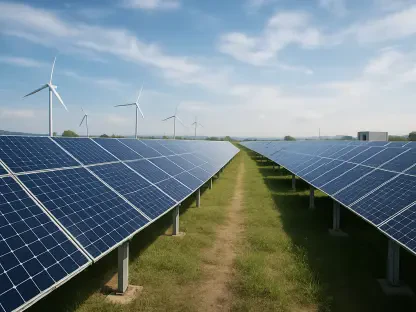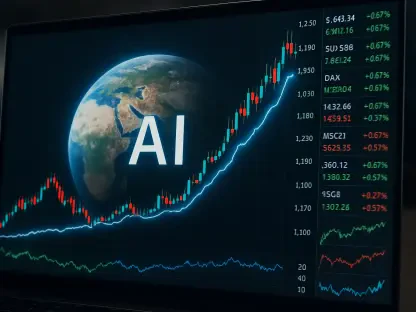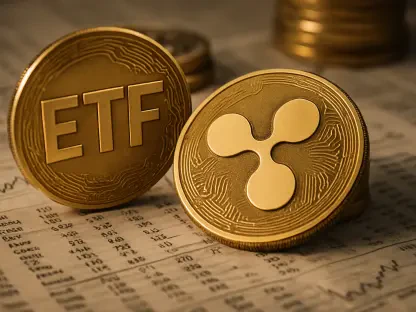As the global economy grapples with a pronounced slowdown in September of this year, a chilling effect is sweeping through commodity markets, reshaping the landscape for producers, consumers, and investors alike, with growth forecasts dipping from a higher rate last year to a mere 3.1% now. This downturn ranks among the weakest performances since the pandemic’s aftermath. Driven by fading post-pandemic recovery momentum, sluggish industrial expansion, soaring energy costs, and pervasive policy uncertainties, the economic environment is stifling demand for essential resources. Commodity prices are tumbling to historic lows, creating a ripple effect that touches every corner of global trade. This exploration delves into the intricate ways these macroeconomic headwinds are altering market dynamics, revealing both the immediate challenges and the broader implications for stakeholders navigating this turbulent terrain.
The decline in commodity prices, projected to fall by 12% this year and an additional 5% in 2026 according to World Bank estimates, underscores the depth of the demand suppression. Beyond just numbers, this economic chill is forcing a reevaluation of supply chains, investment strategies, and operational models across industries. Geopolitical tensions and shifting trade policies further complicate the picture, adding layers of uncertainty that make forecasting a daunting task. As market participants brace for continued volatility, understanding the nuanced impacts across different commodity sectors becomes critical. This analysis aims to unpack these complexities, shedding light on how the current downturn is redefining the global commodity landscape.
Economic Slowdown and Commodity Price Trends
Broad Impacts on Prices
The pervasive economic slowdown, marked by a projected global growth rate of just 3.1%, is exerting significant downward pressure on commodity demand, leading to substantial price declines across the board. Forecasts indicate a drop of 12% in commodity prices for the current year, with an additional 5% decline expected in 2026, pushing real-term prices to their lowest levels since before the COVID-19 crisis. This trend is not merely a statistical anomaly but a reflection of deep-seated challenges in the global economy, where industrial activity is stalling, and consumer spending on resource-intensive goods is curtailed. The ramifications are felt by producers who face shrinking revenues, as well as by nations reliant on commodity exports for economic stability. This broad suppression of demand signals a critical shift, compelling market participants to reassess their strategies in a landscape where traditional growth drivers are faltering.
Compounding the issue of falling prices is the widespread impact on global supply chains, which are struggling to adapt to reduced demand and heightened operational costs. Industries dependent on commodities, from manufacturing to construction, are finding their budgets strained as input costs remain high despite price drops, largely due to persistent inflation in certain sectors. Meanwhile, investors are pulling back from riskier commodity-linked assets, further depressing market sentiment. This cycle of reduced demand and cautious investment creates a feedback loop that exacerbates the economic chill, leaving little room for immediate recovery. For many stakeholders, the focus has shifted to cost-cutting and efficiency measures as they weather a period of unprecedented low valuations in essential resources.
Policy and Geopolitical Influences
Geopolitical tensions and trade policy uncertainties are intensifying the challenges faced by commodity markets, adding a layer of complexity to an already strained economic environment. Shifts in international relations, coupled with measures like increased import tariffs in key economies, are disrupting established trade flows and prompting companies to rethink their global sourcing strategies. These external pressures are not just abstract concerns but tangible forces that influence pricing, supply availability, and market confidence. As nations grapple with balancing economic growth against political priorities, the resulting uncertainty often translates into volatile commodity valuations, making long-term planning a formidable task for industry leaders.
Central bank actions, such as the recent interest rate cut by the U.S. Federal Reserve, are another critical factor shaping market dynamics during this slowdown. While intended to stimulate economic activity, these measures face limitations due to fiscal constraints and lingering inflationary pressures in specific sectors. The impact on commodity markets is twofold: lower interest rates can encourage borrowing and investment, potentially boosting demand for resources, but persistent inflation erodes purchasing power, counteracting these benefits. Governments in commodity-exporting countries are also feeling the pinch, as declining revenues force difficult choices between social spending and debt management. This intricate interplay of policy and geopolitics underscores the multifaceted challenges confronting commodity markets in the current economic climate.
Divergence in Commodity Performance
Industrial Metals and Energy Declines
Industrial metals like copper, aluminum, and iron ore are bearing the brunt of the economic slowdown, with prices plummeting due to weakened demand from key sectors such as manufacturing and construction. Major markets, particularly China, where construction activity has significantly contracted, are driving this decline as infrastructure projects slow and industrial output falters. The cascading effect touches miners and related industries, which are seeing revenues shrink and investment in new projects stall. This downturn in industrial metals reflects a broader struggle within the global economy, where the engines of growth that once fueled commodity demand are sputtering under the weight of high costs and reduced activity.
Energy resources, particularly oil, are similarly under pressure as softened demand from transportation and industrial sectors drags prices down to levels that challenge profitability. With Brent crude hovering at reduced valuations, energy producers are grappling with compressed margins, forcing difficult decisions about capital expenditure and operational scale. The implications extend beyond corporate balance sheets to national economies dependent on energy exports, where budget shortfalls loom large. This sector’s struggles highlight how deeply interconnected commodity markets are with broader economic health, as reduced activity in one area reverberates through the entire value chain, amplifying the chill felt across global trade networks.
Precious Metals Surge
In stark contrast to the declines in industrial metals and energy, precious metals such as gold and silver are experiencing a remarkable surge, reaching record highs as investors seek safe-haven assets amid economic uncertainty. Driven by escalating geopolitical risks, a weakening U.S. dollar, and persistent inflation concerns, this flight to safety reflects a broader trend of risk aversion permeating global markets. Gold, in particular, has become a favored refuge for capital, bolstered by central bank purchases aimed at diversifying reserves away from traditional currencies. This upward trajectory offers a counterpoint to the struggles of other commodities, signaling deep-seated concerns about the stability of the current economic order.
The boom in precious metals is not just a reaction to immediate crises but also a reflection of longer-term shifts in investor behavior, where caution often trumps speculative risk-taking in times of turmoil. Mining companies focused on gold and silver are reaping the benefits, with rising prices translating into robust financial performance and heightened investor interest. However, this surge also underscores the uneven impact of the economic chill, as gains in one sector do little to alleviate the pressures faced by others. For market participants, the strength of precious metals serves as both an opportunity for portfolio diversification and a reminder of the pervasive uncertainty that continues to shape global economic sentiment.
Agricultural Market Complexities
Agricultural commodities are navigating a uniquely challenging landscape, with global prices projected to decline by 7% this year due to improved crop yields and fewer export restrictions. This oversupply is exerting downward pressure on valuations, affecting producers who must contend with reduced revenues while input costs like fertilizers and fuel remain stubbornly high. The result is a squeeze on margins that tests the resilience of agricultural giants and smaller farmers alike. While the broader trend suggests a softening market, this global picture masks significant regional disparities that add another layer of complexity to the sector’s outlook during the economic slowdown.
Regional crises, such as severe flooding in areas like Pakistan, reveal the fragility of localized supply chains and their potential to disrupt broader market stability. These events can trigger sudden price spikes for staples like wheat and rice, countering the global trend of declining costs and creating economic instability in affected regions. For traders and producers, this duality demands agility to manage both oversupply pressures and unpredictable shocks. The agricultural sector’s experience during this economic chill illustrates how global and local forces can collide, producing outcomes that defy uniform predictions and require tailored strategies to mitigate risks and capitalize on fleeting opportunities.
Corporate and Industry Responses
Mixed Outcomes for Public Companies
Public companies operating within or reliant on commodity markets are experiencing a wide range of outcomes as the economic slowdown takes hold. Firms in the industrial metals and energy sectors, such as major mining corporations and oil producers, are facing significant revenue pressures due to falling prices, with profitability taking a hit as demand from key industries wanes. In contrast, precious metals miners are capitalizing on soaring gold and silver prices, positioning themselves as attractive options for risk-averse investors. This disparity highlights the uneven impact of the current economic climate, where market conditions favor some while punishing others with little reprieve.
Agricultural giants are also feeling the strain, grappling with reduced margins as commodity prices drop while operational costs remain elevated, creating a challenging financial environment. Meanwhile, companies tied to the green energy transition, such as those producing lithium for electric vehicles, are navigating short-term headwinds but remain optimistic about long-term structural demand. These varied outcomes underscore the necessity for strategic adaptation, as firms must balance immediate financial challenges with investments in future growth areas. The diversity of corporate performance paints a vivid picture of a market in flux, where resilience and foresight are critical to weathering the storm.
Structural Shifts and Strategic Adaptation
Beyond immediate financial impacts, the economic slowdown is catalyzing structural shifts within industries reliant on commodities, prompting a reevaluation of long-standing operational models. Companies are increasingly prioritizing supply chain resilience, exploring near-shoring and friend-shoring initiatives to mitigate risks posed by geopolitical tensions and trade uncertainties. This strategic pivot is not merely a reaction to current conditions but a proactive step toward building more robust frameworks that can withstand future disruptions. The focus on diversification reflects a broader recognition that global instability is likely to persist, necessitating innovative approaches to sourcing and distribution.
Sustainability and operational efficiency are also emerging as central pillars of industry transformation during this economic chill. Firms are investing in technologies and practices that reduce environmental impact while cutting costs, aligning with global decarbonization goals even as short-term economic pressures mount. This dual focus on immediate survival and long-term responsibility is reshaping industry standards, pushing companies to rethink how they allocate resources and measure success. As these structural changes unfold, they signal a fundamental shift in how commodity-dependent industries operate, positioning those who adapt swiftly at a competitive advantage in an evolving market landscape.
Long-Term Trends and Future Outlook
Green Energy Transition Opportunities
Despite the immediate economic woes casting a shadow over commodity markets, the long-term push for decarbonization offers a beacon of hope, particularly for materials tied to the green energy transition. Demand for “green” metals like lithium, nickel, and copper, which are essential for electric vehicles and renewable energy infrastructure, remains a promising growth area. Even as cyclical downturns suppress short-term valuations, the structural need for these resources is undeniable, driven by global commitments to reduce carbon emissions and shift toward sustainable energy systems. This enduring trend presents a counterbalance to current challenges, offering a pathway for strategic investment.
Companies and investors focusing on these critical minerals are positioning themselves to capitalize on future demand, recognizing that the transition to a low-carbon economy will reshape commodity priorities over the coming decades. While immediate market conditions may deter aggressive expansion, those with the foresight to invest in capacity and innovation now could secure significant advantages as the green energy sector matures. Governments are also playing a role, with policies supporting renewable energy adoption indirectly bolstering demand for these materials. This intersection of policy, industry, and market dynamics underscores the potential for green metals to drive recovery and growth in a post-slowdown world.
Continued Volatility and Strategic Needs
The outlook for commodity markets remains fraught with volatility, as short-term pressures are expected to persist across most sectors due to ongoing economic challenges and subdued demand. Industrial metals and energy resources, in particular, face continued headwinds as key industries like manufacturing and transportation struggle to regain momentum. Agricultural markets, while benefiting from global oversupply, remain vulnerable to regional disruptions that could unsettle pricing stability. This unpredictable environment demands caution from market participants, who must navigate a landscape where recovery timelines are uncertain and external shocks are a constant threat.
However, amidst this volatility, opportunities are emerging for those willing to adopt forward-thinking strategies, particularly in safe-haven assets like precious metals and in sectors tied to long-term growth such as green materials. Emphasizing cost control, operational efficiency, and supply chain diversification will be crucial for stakeholders aiming to weather the current economic chill. Additionally, identifying undervalued assets in struggling sectors could yield significant returns as markets stabilize. The path forward requires a delicate balance of risk management and strategic investment, ensuring that firms and investors are prepared not just to survive the present downturn but to thrive in the transformative shifts that lie ahead.









